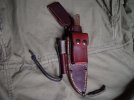- Joined
- Nov 20, 2008
- Messages
- 10,188
Thanks Moose,
You're an education on Ka-bars. Cheap as in cheaply made wasn't my intent. Cheap as in folks are getting a hell'va good deal cheaply is what I meant, cheap as in it should cost more, well...I hope you get my idea.
From a knifemakers viewpoint this knive isn't easy to make, primarily due to the fuller. Fullers are a pain to do by hand, getting the fuller aligned with the bevel and spine even more so. The handle is labor intensive, surprisingly. But cutting and shaping the leather, gluing, sanding took a surprisingly long time. It's not a knife I will ever make a lot of.
Changes? Simple things such as a spine that is 1/8 " to 3.16's at the spine with a distal grind, a slightly wider blade, more shallow but equally wide fullers, and a more robust tang. With modern steels and diamond sharpeners, there's also no reason not to bring it up to 60RC, and the spine will be drawn back. The blade will, naturally, be forged. Otherwise, it will look exactly the same. On the one I've made, the balance is almost exactly in front of the guard, the guard will also be slightly thicker also, as I just don't like the look of the original. I didn't weigh it, but at least to me, it's light as a feather. The blade will be unmarked, with the exception of signature, unless you want something else added. As for steel, since you've left it to me, I'll have to think about it. I'll expect you to put it through it paces, and since this started here in the Ka-Bar forum, you'd be quite welcome to post any results you wish. I know that's a big one, so I'd make it as best as I can. We can discuss other aspects through Pm's.
You're an education on Ka-bars. Cheap as in cheaply made wasn't my intent. Cheap as in folks are getting a hell'va good deal cheaply is what I meant, cheap as in it should cost more, well...I hope you get my idea.
From a knifemakers viewpoint this knive isn't easy to make, primarily due to the fuller. Fullers are a pain to do by hand, getting the fuller aligned with the bevel and spine even more so. The handle is labor intensive, surprisingly. But cutting and shaping the leather, gluing, sanding took a surprisingly long time. It's not a knife I will ever make a lot of.
Changes? Simple things such as a spine that is 1/8 " to 3.16's at the spine with a distal grind, a slightly wider blade, more shallow but equally wide fullers, and a more robust tang. With modern steels and diamond sharpeners, there's also no reason not to bring it up to 60RC, and the spine will be drawn back. The blade will, naturally, be forged. Otherwise, it will look exactly the same. On the one I've made, the balance is almost exactly in front of the guard, the guard will also be slightly thicker also, as I just don't like the look of the original. I didn't weigh it, but at least to me, it's light as a feather. The blade will be unmarked, with the exception of signature, unless you want something else added. As for steel, since you've left it to me, I'll have to think about it. I'll expect you to put it through it paces, and since this started here in the Ka-Bar forum, you'd be quite welcome to post any results you wish. I know that's a big one, so I'd make it as best as I can. We can discuss other aspects through Pm's.
Last edited:


